Claw Toe Muscles...
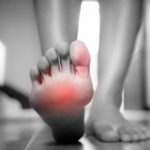
Claw toes and foot pain can be caused by trigger points in the long toe flexors (flexor digitorum longus and flexor hallucis longus). You may not be bothered by your claw toes but they are an important symptom of imbalance for a skilled myofascial therapist.
You may also feel pain from these muscles on the ball of the foot and the bottom of the big toe. To get more familiar, we'll call these muscles the "long toes flexor" and the "big toe flexor"
Pain is no fun. However, if we have myofascial dysfunction in these long toe flexors, it can impact our balance, our 'drive' in sports activities and our general performance and stability when running and walking. And they even cause claw toes! Why are they so important?
Claw Toe Muscles...

Claw toes and foot pain can be caused by trigger points in the long toe flexors (flexor digitorum longus and flexor hallucis longus). You may not be bothered by your claw toes but they are an important symptom of imbalance for a skilled myofascial therapist.
You may also feel pain from these muscles on the ball of the foot and the bottom of the big toe. To get more familiar, we'll call these muscles the "long toes flexor" and the "big toe flexor"
Pain is no fun. However, if we have myofascial dysfunction in these long toe flexors, it can impact our balance, our 'drive' in sports activities and our general performance and stability when running and walking. And they even cause claw toes! Why are they so important?
Claw Toes and Foot Pain
If you are developing claw toes and foot pain, you may have trigger points in your long toe flexors. These are really a type of hammer toe. True claw toes are usually from a serious skeletal or neurological deficit, but we’ll stick with the common lingo. Claw toes can happen if you have flat feet. The primary cause of flat feet is hypermobility of the bones in the foot. Then, your long toe flexors may try to stabilize your foot. However, instead of stabilizing it, they overcome the smaller lumbricals and other muscles between your metatarsals and well as the quadratus plantae muscle on the bottom of your foot. This allows claw toes to form. The smaller toes may also deviate to the outside of your foot. This both painful and unsightly. It is less common, but you can also develop claw toes if your soleus and gastroc are weak. Your deeper leg muscles, including the toe flexors, may try to compensate for this. The toe flexors gain advantage over muscles in between the foot bones in a way that ‘grips’ the floor. This makes all the toes claw. If your big toe is pointed inward, as with pointy shoes, your big toe flexor will tend to increase this, rather than flexing your toe. That is half of the process of forming a bunion. Avoiding pointy shoes is especially important for children and young women. If you make into your 20’s without developing a bunion, you are much less likely to develop one later in life. More details about the anatomy and function of these muscles in in the Extras section at the end of this article.
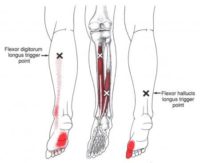 You are most likely to activate trigger points in the long toe flexors if you walk or run on uneven surfaces. Running or walking barefoot on sand requires especially powerful toe curling action. You can also have problems with worn out shoes, especially when running.
You are most likely to activate trigger points in the long toe flexors if you walk or run on uneven surfaces. Running or walking barefoot on sand requires especially powerful toe curling action. You can also have problems with worn out shoes, especially when running.
Most 21st century Americans have not grown up running and walking barefoot, so we need both the cushion and support of a reasonably good shoe
Another common challenge is running on crowned roads. For instance, if you run against the traffic, you are running with your left side lower on the crown of the road than your right side. If you return on the same road you will repeat the pattern.
Most of us have not had any treatment of the long toe flexors because it is not often diagnosed. However, it is quite common. In fact, problems with this muscle occur very often in conjunction with plantar fasciitis. We also see this frequently in syndromes that involve other lateral stabilizers of the ankle such as the fibularis longus and tibialis anterior. Treatment of your toe flexors is often missed because it is secondary to the primary problem.
Traditional treatment for claw toes has usually been limited to surgery to lengthen the tendons with mixed results. Fortunately, claw toes and foot pain can often be relieved without surgery if caught early. The key is to treat the correct muscles, releasing taut bands and trigger points and restoring balance.
Myofascial Treatment of Claw Toes and Foot Pain
Self Compressions
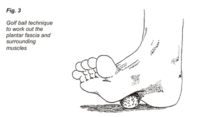 You will find that both a rolling pin and a golf ball are helpful tools. Use the golf ball roll back and forth along the toe flexors and quadratus plantae. You can also use it to roll more across the ball of your foot the target the adductor hallucis, which pulls your big toe to the center.
You will find that both a rolling pin and a golf ball are helpful tools. Use the golf ball roll back and forth along the toe flexors and quadratus plantae. You can also use it to roll more across the ball of your foot the target the adductor hallucis, which pulls your big toe to the center.
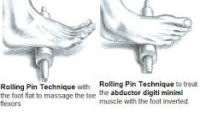 You can also use a rolling pin to reach muscles on the outside edges of the feet, such as the aBductors of your big and little toes. These muscles are used to spread/splay your toes.
You can also use a rolling pin to reach muscles on the outside edges of the feet, such as the aBductors of your big and little toes. These muscles are used to spread/splay your toes.
Other Techniques
Because some of these muscles are quite deep they are more difficult to reach with massage techniques than some other muscles in the foot. They are not very responsive to kinesio taping, traditional ultrasound or other superficial techniques. However, we easily can target trigger points in these muscles with acoustic compression therapy.
Stretches
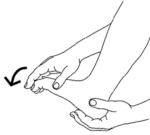 You should stretch your flexors and extensors. Begin seated and gently flex and extend the toes. Then grasp the toes and gently flex them. Work all the toes together. For this and the remaining stretches, try this technique: Alternate gently extending/flexing against resistance, relaxing and ‘picking up the slack’. Try this three times, slowly.
You should stretch your flexors and extensors. Begin seated and gently flex and extend the toes. Then grasp the toes and gently flex them. Work all the toes together. For this and the remaining stretches, try this technique: Alternate gently extending/flexing against resistance, relaxing and ‘picking up the slack’. Try this three times, slowly.
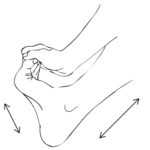 However, many people experience cramping when stretching the extensors. You would fix that with a flexor stretch.
However, many people experience cramping when stretching the extensors. You would fix that with a flexor stretch.
You can deepen this stretch a bit by using a towel under your foot. The towel will pull up against the toes and will allow you to carefully apply a bit more force.
Strengthening
You may benefit from simple strengthening exercises for your toe flexors. For instance, for runners and other athletes, it may be helpful to increase the strength and aerobic capacity of both the long toe flexors.
However, you should consult a licensed therapist or certified trainer skilled in assessing the muscles in your feet and the stabilizing muscles of your calf before beginning a strengthening program.
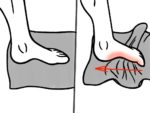 One simple and safe way to build up the toe flexors is to scrunch up something with them. In the ‘towel scrunch’ you can begin with something very thin and light, like a tissue.
One simple and safe way to build up the toe flexors is to scrunch up something with them. In the ‘towel scrunch’ you can begin with something very thin and light, like a tissue.
Then, progress through paper towels, thin cloth, a light wash cloth and hand towel. You can also use marbles or small rubber balls of different sizes.
Some approaches use standing toe push-ups against your body weight or calibrated resistance band training.
This video is a good example of resistance band training for the long toe flexors.
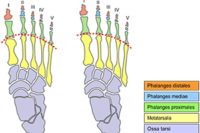 If you have trigger points in the calves we will usually want to check you for Morton's Foot Structure (MFS). This common skeletal variation makes your foot want to pronate. So it makes sense that a muscle whose primary function is to resist pronation would be unhappy.
A simple correction with a posture control insert is usually all that is needed. Less often, the bones in the foot move too much and the arch has fallen. This requires an appropriate arch support that can be added to the posture control insole.
Next, we will probably perform a preliminary screening for differences in leg length. Because of the role of the fibs as lower muscular outrigger, a difference in the length of your legs makes these muscles work harder. Finally, we will also probably screen you to see if the two sides of your pelvis are different sizes.
Unsurprisingly, if you have a combination of these structural variations, they will compound each other. Fortunately, we can easily correct all three conditions. This makes other treatments much more effective.
If you have trigger points in the calves we will usually want to check you for Morton's Foot Structure (MFS). This common skeletal variation makes your foot want to pronate. So it makes sense that a muscle whose primary function is to resist pronation would be unhappy.
A simple correction with a posture control insert is usually all that is needed. Less often, the bones in the foot move too much and the arch has fallen. This requires an appropriate arch support that can be added to the posture control insole.
Next, we will probably perform a preliminary screening for differences in leg length. Because of the role of the fibs as lower muscular outrigger, a difference in the length of your legs makes these muscles work harder. Finally, we will also probably screen you to see if the two sides of your pelvis are different sizes.
Unsurprisingly, if you have a combination of these structural variations, they will compound each other. Fortunately, we can easily correct all three conditions. This makes other treatments much more effective.
Avoid walking or running on uneven surfaces. Walking on sand presents special challenges and results in a significant amount of toe flexing or gripping.
If you are a runner, take a break. This includes treadmills and ellipiticals. Initially, substitute swimming, rowing or cycling for aerobic activity for a while. You may also be working on deconditioned leg and foot muscles during this time.
If possible, resume running on an elliptical. This reduces strain on your toes. Then, you can move up to a treadmill or other flat, level surface. Avoid slanted or uneven surfaces.
Avoid gripping the floor from wheeled desk chairs with your toe flexors.
If you are have gout or pseudo-gout it is important to manage it effectively.
Check your shoes that you wear regularly:
- Avoid spike heels completely
- Make sure shoes are not generally too tight.
- Try to make sure the sole and heel have some spring.
- The toe box should be large enough to move your toes
- The vamp (the lower, middle part) of your shoes should have enough room to reduce cramping.
- The soles of your shoes should be flexible. Avoid most Dansko’s and other shoes with thick plastic, wood block or platform soles.
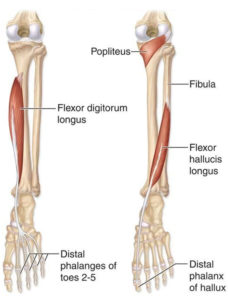 You may find it helpful to review a little bit of the anatomy to understand how these muscles work. In this illustration all of the overlying muscles have been removed for clarity.
You may find it helpful to review a little bit of the anatomy to understand how these muscles work. In this illustration all of the overlying muscles have been removed for clarity.
The long toe flexors are located VERY deep to both of them. Each of them attaches to the back of the tibia and proceeds down toward the foot.
The tendon of the long toes flexor muscle (flexor digitorum longus) attaches to the tips of underside of each of the 2nd-4th toes. This muscle provides most of the power in toe flexion.
In addition, we can see that the big toe flexor (flexor hallucis longus) crosses over the outside of the back of the leg to the inside. It attaches to the tip of the underside of the big toe.
Your long toe flexors are used to grip or flex strongly with your toes. They also help the soleus, gastroc and tibialis posterior with plantar flexion of your ankle. Finally, they have a subtle, but important impact on inversion of the foot, assisting both the tibialis anterior and posterior. Improper engagement of the toe flexors causes claw toes and foot pain.
In standing, it is difficult to maintain balance if your long big toe flexor is not working effectively. This muscle is very important for maintaining balance when leaning forward or in forward motion.
When we are walking or running, both of the long toe flexors act strongly as we shift our weight. When we are on one foot, both of these muscles are very active and help stabilize your foot and leg. This is what happens during the “mid-stance” portion of our gait on the standing leg with every step.
“The long toe flexors help the provide the ‘drive’ in many sports activities”
The primary toes flexor is more strongly active in jumping, running and initiating movement in other sports activities than the big toe flexor. In some athletes, overloading the toe flexors can cause severe pain deep in the calf, sometimes referred as shin splints or chronic compartment syndrome.
